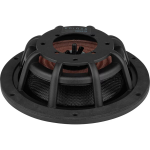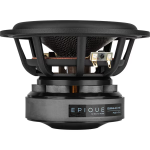Hi,
For my under the sofa subwoofer this is what I am going to do:-
1) Make two boxes of 6th order bandpass using 6.5 sub driver in each box ie both sides ported, technically. Bandwidth is 25Hz to 100hz, that's 2 octaves well within limits of this alignment

2) Now to save space actually use PRs on both the sides instead of ports to make two small enclosures. With placement slightly apart I ensure that there are four sources on the high side, the four sources spaced apart help prevent localization. The fact that the bandpass is acoustically filtered on the high side further helps suppress localization.

There are deliberate four sources, on the 100Hz high side, to form sort of a small line array, they add up considerable SPL due to near placement to each other as well as near placement to anyone on the sofa. Anywhere else in the room I dont care.
The 6.5' drivers are used to extract the most from the 6th order alignment I will never feel SPL lacking.
What do you think?
Warm Regards,
WonderfulAudio
For my under the sofa subwoofer this is what I am going to do:-
1) Make two boxes of 6th order bandpass using 6.5 sub driver in each box ie both sides ported, technically. Bandwidth is 25Hz to 100hz, that's 2 octaves well within limits of this alignment
2) Now to save space actually use PRs on both the sides instead of ports to make two small enclosures. With placement slightly apart I ensure that there are four sources on the high side, the four sources spaced apart help prevent localization. The fact that the bandpass is acoustically filtered on the high side further helps suppress localization.
There are deliberate four sources, on the 100Hz high side, to form sort of a small line array, they add up considerable SPL due to near placement to each other as well as near placement to anyone on the sofa. Anywhere else in the room I dont care.
The 6.5' drivers are used to extract the most from the 6th order alignment I will never feel SPL lacking.
What do you think?
Warm Regards,
WonderfulAudio
A single 6.5" driver will be quite limited at 25 Hz. But if you're ok with that - good.What do you think?
The 25 Hz PR needs to have a lot of displacement. Either big Xmax or Sd.
Thanks for the quick reply. There are two such subs, not one. I will DIY the PR, I will make a slaps style PR for greater excursion capability. They offer greater than 20mm one way excursion.A single 6.5" driver will be quite limited at 25 Hz. But if you're ok with that - good.
The 25 Hz PR needs to have a lot of displacement. Either big Xmax or Sd.
At 25Hz, the pair of 6.5" PR at 20mm excursion are only capable of ~100dB output, sounding about as loud as 40dB at 1kHz. It will be interesting to feel how your couch cushions resonate at various frequencies.2) Now to save space actually use PRs on both the sides instead of ports to make two small enclosures.
The 4x5" PRs only require 1mm excursion for 100dB output.
There will be a "hot spot" ("butt ticklers") transmitted through the sofa cushions by each of the four sources.With placement slightly apart I ensure that there are four sources on the high side, the four sources spaced apart help prevent localization.
I think experimenting with speakers under your couch to find out where your room peaks and nulls lie before committing to the under couch build would be a good idea.The 6.5' drivers are used to extract the most from the 6th order alignment I will never feel SPL lacking.
What do you think?
Last edited:
Hi GM,I think experimenting with speakers under your couch to find out where your room peaks and nulls lie before committing to the under couch build would be a good idea.
Being so near field to the four array sources, I assume the room is out of the equation. All the room reflections will be far smaller in SPL. That's what is encouraging me to try this whole complication.
Warm Regards,
WonderfulAudio
Hi,
By the way, has anyone ever got a tight sounding sub with a 6th order sub, if built and integrated properly?
Warm Regards,
WonderfulAudio
By the way, has anyone ever got a tight sounding sub with a 6th order sub, if built and integrated properly?
Warm Regards,
WonderfulAudio
Bandpass is typically designed to be loud.
So have not spent much time with " Hi Fi" applications.
Cone excursion is limited at 2 points in the bandwidth.
So it is typical drawback of ported x2
Close to the couch is a fun experience for movie sound effects
Something I have only done with ported larger woofers.
For something small, assuming low efficiency would likely use Epique system
but availability is likely drying up. The driver and passive are already designed and matching
driver linear travel is 14mm and passive 19mm


So have not spent much time with " Hi Fi" applications.
Cone excursion is limited at 2 points in the bandwidth.
So it is typical drawback of ported x2
Close to the couch is a fun experience for movie sound effects
Something I have only done with ported larger woofers.
For something small, assuming low efficiency would likely use Epique system
but availability is likely drying up. The driver and passive are already designed and matching
driver linear travel is 14mm and passive 19mm


Last edited:
I made a "small" 6th order bandpass for testing, have a look here: https://www.diyaudio.com/community/...-port-resonance-absorbers.388264/post-7434308tight sounding sub with a 6th order sub
Generally resonators such as a 6th order bandpass has steep roll off slopes and thus high group delay. Not exactly optimum for "tight sounding".
But I cannot tell you if "tight sounding" is really that strongly correlated to group delay.
Transient is considered a sudden change rather frequency or amplitude.
Rather, long ringing held notes or sounds, go to fast repeated notes. or vise versa
Or soft notes or dynamics quickly go soft then loud or vise versa.
The heavy cone of a sub being able to change quickly to transients is magnet control
and not a weak amplifier that can deal with the same.
As with ported, no wires to a port the energy comes from somewhere. the speaker.
Once the port conducts the cone travel is heavily restricted. So transient slightly above port tuning
and slightly below port tuning befor unloading is junk. But even 30 cycles in a second is enough to fool you to imagine more bass.
Tight bass is fast transient so usually a very powerful magnet and good suspension.
Not restricted by a too small box, or no control lost from a too large box.
And then putting the port way way way down low so actual response is actual cone movement.
not poofy doofy fake air.
Low Qts Low Fs, and the right size box. Fs dictates the tuning so how low does it go.
Bandpass restricts the cone down low like ported and depending on order also restricts
movement up high. Which is why mentioned transient would be poor near tuning like ported
x2. the top of the bandwidth and low end of the bandwidth.
Sealed considered fast and tight because no cone movement is restricted to the power the port.
You can of course ruin it with a too small box, or the speaker has a weak magnet, higher than .3 to .4 Qts
.3 meaning powerful magnet .6 meaning junk
Rather, long ringing held notes or sounds, go to fast repeated notes. or vise versa
Or soft notes or dynamics quickly go soft then loud or vise versa.
The heavy cone of a sub being able to change quickly to transients is magnet control
and not a weak amplifier that can deal with the same.
As with ported, no wires to a port the energy comes from somewhere. the speaker.
Once the port conducts the cone travel is heavily restricted. So transient slightly above port tuning
and slightly below port tuning befor unloading is junk. But even 30 cycles in a second is enough to fool you to imagine more bass.
Tight bass is fast transient so usually a very powerful magnet and good suspension.
Not restricted by a too small box, or no control lost from a too large box.
And then putting the port way way way down low so actual response is actual cone movement.
not poofy doofy fake air.
Low Qts Low Fs, and the right size box. Fs dictates the tuning so how low does it go.
Bandpass restricts the cone down low like ported and depending on order also restricts
movement up high. Which is why mentioned transient would be poor near tuning like ported
x2. the top of the bandwidth and low end of the bandwidth.
Sealed considered fast and tight because no cone movement is restricted to the power the port.
You can of course ruin it with a too small box, or the speaker has a weak magnet, higher than .3 to .4 Qts
.3 meaning powerful magnet .6 meaning junk
Last edited:
Post the build pics!Thanks for the quick reply. There are two such subs, not one. I will DIY the PR, I will make a slaps style PR for greater excursion capability. They offer greater than 20mm one way excursion.
- Home
- Loudspeakers
- Subwoofers
- Is this 6th order undersofa bandpass idea good?